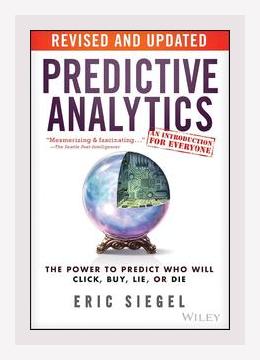Technology and Digital TransformationData Analytics
Introduction: The New Scientific Era of Prediction
Eric Siegel’s “Predictive Analytics: The Power to Predict Who Will Click, Buy, Lie, or Die” delves into the capabilities of predictive analytics and its transformative impact across various fields. Predictive analytics leverages statistical techniques to analyze current and historical data in order to make predictions about future events. This summary explores the key themes, principles, and real-world applications Siegel presents in the book and distills actionable steps based on these insights.
1. The Power and Utility of Predictive Analytics
Overview:
Predictive analytics is highlighted as a revolutionary tool that drives decisions and strategies in businesses, healthcare, law enforcement, and many other domains. It predicts who will click on ads, buy products, commit fraud, and even who might die from certain illnesses.
Key Examples:
- Retail Marketing: Companies like Amazon and Netflix use predictive analytics to recommend products and content to users.
- Healthcare: Predictive models assess patient readmission risks and forecasting outbreak patterns for diseases.
- Finance: Credit scoring models predict the likelihood of individuals defaulting on loans.
Actionable Advice:
- Business Implementation: Companies should start by identifying specific business problems that can be addressed through predictive analytics, such as customer churn prediction or sales forecasting.
- Data Collection: Prioritize gathering comprehensive and clean datasets to build accurate predictive models.
2. Data is the New Oil: The Role of Big Data
Overview:
Siegel emphasizes that the vast amounts of data generated today (termed ‘Big Data’) serve as the foundation for predictive models. This data comes from varied sources such as social media activities, transaction histories, GPS logs, and more.
Key Examples:
- Social Media Analysis: Predicting election outcomes by analyzing social media sentiment.
- Consumer Behavior: Retailers like Walmart analyze millions of transactions to optimize inventory and personalize marketing efforts.
Actionable Advice:
- Data Integration: Consolidate data from various sources to create a rich dataset for analysis.
- Data Privacy: Ensure adherence to data privacy laws and ethical guidelines when collecting and using personal data.
3. Building Predictive Models
Overview:
The book details the process of developing predictive models, which involves selecting the right algorithms, cleaning and preparing data, training the model, and validating its accuracy.
Key Examples:
- Fraud Detection: Credit card companies utilize machine learning algorithms to predict and prevent fraudulent transactions in real-time.
- Crime Prediction: Police departments use predictive modeling to allocate resources by forecasting crime hotspots.
Actionable Advice:
- Algorithm Selection: Experiment with various algorithms to determine which provides the best predictive accuracy for your specific problem.
- Model Tuning: Fine-tune model parameters to improve performance and reduce errors.
4. The Predictive Power Paradox
Overview:
Siegel introduces the concept of the Predictive Power Paradox — the idea that even though predictions can be incredibly powerful, they are not always perfect or certain. The key is striking a balance between accuracy and practical utility.
Key Examples:
- Customer Retention: Predictive models can indicate which customers are likely to leave (churn), but they are not 100% accurate.
- Policy Impact: Predictive analytics can forecast the impact of public policies, although unforeseen variables can affect outcomes.
Actionable Advice:
- Risk Assessment: Use prediction to identify high-risk cases but consider a margin of error in decision-making.
- Scenario Planning: Develop multiple scenarios based on predictive outcomes and prepare contingency plans accordingly.
5. Ethical Implications and Bias in Predictive Analytics
Overview:
Ethical considerations are paramount in predictive analytics. Models can sometimes perpetuate existing biases found in the data and decisions should be made with awareness of these implications.
Key Examples:
- Judicial Decisions: The use of predictive analytics in sentencing and parole decisions has raised concerns about fairness and bias.
- Recruitment: Predictive tools for hiring must avoid discriminating based on race, gender, or other protected characteristics.
Actionable Advice:
- Bias Mitigation: Regularly audit predictive models to identify and correct biases.
- Transparency: Maintain transparency with stakeholders about how predictive models are being used and their decision-making criteria.
6. Case Studies: Successes and Lessons Learned
Overview:
Siegel presents numerous case studies that demonstrate both the successes and challenges of implementing predictive analytics across various sectors.
Key Examples:
- Target Corporation: The retailer used predictive models to identify pregnant customers and send them tailored promotions — a tactic that resulted in both success and controversy.
- Michigan Department of Education: Implemented predictive analytics to identify students at risk of dropping out.
Actionable Advice:
- Learn from Others: Study successful case studies and apply similar strategies while being mindful of the lessons and pitfalls encountered.
- Pilot Programs: Conduct small-scale pilots before a full rollout to validate the effectiveness of predictive models.
7. The Future of Predictive Analytics
Overview:
The future of predictive analytics is promising, with advancements in artificial intelligence (AI) and machine learning poised to enhance its accuracy and broaden its applications.
Key Examples:
- Personalized Medicine: Innovations in genomic data analysis are leading to highly personalized treatment plans.
- Autonomous Vehicles: Predictive algorithms play a crucial role in enabling self-driving cars to navigate and make decisions.
Actionable Advice:
- Embrace Innovation: Stay updated with the latest developments in AI and machine learning.
- Continuous Improvement: Regularly update predictive models with new data and techniques to improve their relevance and accuracy.
Conclusion: Harnessing the Power of Prediction
Predictive analytics is a potent tool that, when used ethically and effectively, can drive significant improvements in decision-making and operational efficiency across sectors. By understanding its principles, learning from concrete examples, and applying actionable strategies, individuals and organizations can leverage predictive analytics to forecast the future more accurately and shape it to their advantage.
